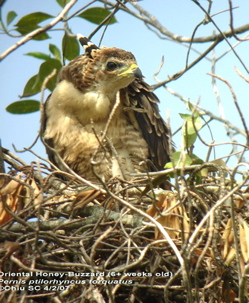An earlier posting reported on the 10-year breeding cycle of a pair of the Oriental Honey-buzzard (Pernis ptilorhyncus torquatus) in Perak, Malaysia.
The female was mainly involved in the incubation of the eggs, although the male occasionally helped. She sat quietly in the nest, with only the tail and occasionally the top of the head visible. A string of calls was often heard, presumably when she felt the presence of danger. This may be to alert her mate. Length of incubation was extimated as 42-47 days.
Once the chicks were hatched, the adults became protective. Most of the time an adult would be by the nest, either to keep off prey or to provide shelter from the sun or rain. The male would deliver the food and feed the chicks.
Larvae of bees (Apis cerana) and honeycombs were the favourite food brought to the chicks in the nest as well as the fledglings. Other food eaten by the adults and juveniles included a green tree snake, bird nestlings, and grubs taken off the bark of trees.
The honey-buzzard would typically stay on a high perch patiently waiting for a prey to appear. It would then zoomed in for the kill. It also made regular raids on beehives and bird nests.
The above has been abstracted from a paper “Observations on the breeding ecology of Oriental Honey Buzzard Pernia ptilorhyncus torquatus in Ipoh, Perak, Malaysia” that Chiu Sein Chiong presented at the Asian Raptor Research and Conservation Network’s 4th Asian Raptor Symposium held in Taiping, Perak, Malaysia in October 2005. KC has been instrumental in getting the above blogged. Images, from top: 4 weeks old chick (Chiu Sein Chiong), 6 weeks plus chick (Chiu Sein Chiong), fledgling (Connie Khoo).










One Response
Once I originally commented I clicked the -Notify me when new feedback are added- checkbox and now every time a remark is added I get 4 emails with the same comment. Is there any means you may remove me from that service? Thanks!